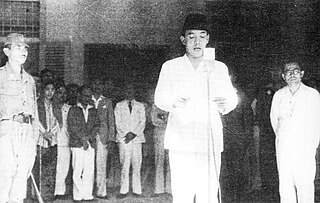
The Indonesian National Revolution, also known as the Indonesian War of Independence, was an armed conflict and diplomatic struggle between the Republic of Indonesia and the Dutch Empire and an internal social revolution during postwar and postcolonial Indonesia. It took place between Indonesia's declaration of independence in 1945 and the Netherlands' transfer of sovereignty over the Dutch East Indies to the Republic of the United States of Indonesia at the end of 1949.
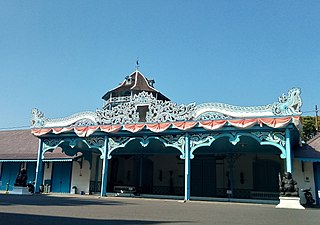
Surakarta, known colloquially as Solo, is a major city in Central Java, Indonesia. The 46.72 km2 (18.04 sq mi) city adjoins Karanganyar Regency and Boyolali Regency to the north, Karanganyar Regency and Sukoharjo Regency to the east and west, and Sukoharjo Regency to the south. On the eastern side of Solo lies Solo River. Its metropolitan area, consisting of Surakarta City and the surrounding six regencies, was home to 6,837,753 inhabitants according to the official estimates for mid 2023, 526,870 of whom reside in the city proper.

Japanese Surrendered Personnel (JSP) was a designation for Japanese prisoners of war developed by the government of Japan in 1945 after the end of World War II in Asia. It stipulated that Japanese prisoners of war in Allied custody would be designated as JSP, which were not subject to the Third Geneva Convention's rules on prisoners, and had few legal protections. The Japanese government presented this proposal to the Allies, which accepted it even though the concept lacked a legal basis, as they were suffering from manpower shortages.
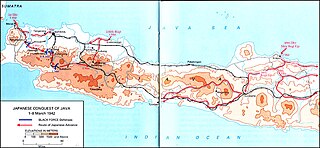
The Battle of Java was a battle of the Pacific theatre of World War II. It occurred on the island of Java from 28 February – 12 March 1942. It involved forces from the Empire of Japan, which invaded on 28 February 1942, and Allied personnel. Allied commanders signed a formal surrender at Japanese headquarters at Bandung on 12 March.

Ambarawa is a town located between the city of Semarang and Salatiga in Central Java, Indonesia. Administratively, it is bordered by the districts of Banyubiru to the south, Jambu to the west, Bandungan to the north, and Bawen to the east.

This is the timeline of Indonesian National Revolution.
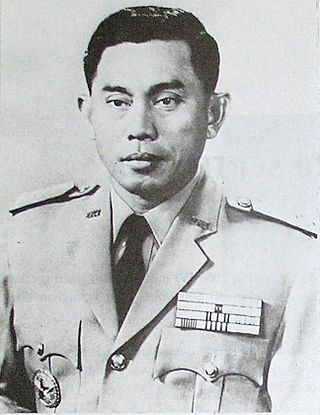
General Ahmad Yani was the Commander of the Indonesian Army, and was killed by members of the 30 September Movement during an attempt to kidnap him from his house.
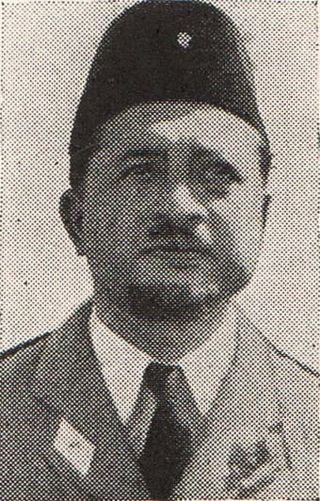
General Gatot Soebroto was an Indonesian general who began his military career with the Royal Dutch East Indies Army (KNIL) and rose to be deputy Army chief-of-staff.

The Ambarawa Railway Museum is a museum located in Ambarawa in Central Java, Indonesia. The museum preserves around 21 steam locomotives and focuses on tourism train tours hauled by 3 operational steam engines and a hydraulic diesel engine, using the remains of the closing of the 3 ft 6 in (1,067 mm) railway line.
Probosutedjo was a businessman and the younger half-brother of former Indonesian president Suharto. Like many Indonesians, he took only one name. Probosutedjo was one of seven children from his mother's second marriage, his father being Atmopawiro and his mother Sukirah. Like Suharto, he was born and raised in the small hamlet of Kemusuk to the west of the main town of Yogyakarta..
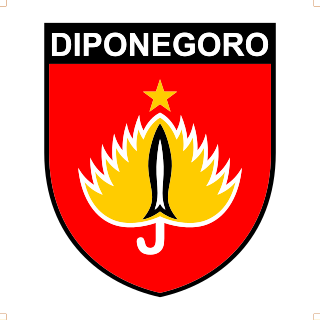
KODAM IV/Diponegoro or IV Military Regional Command/Diponegoro is a military area command of the Indonesian Army. It covers the provinces of Central Java and Special Region of Yogyakarta on the island of Java. It is named after the Java War hero Prince Diponegoro. It appears to have been first established in 1950, and inherited the heritage of the former 3rd Diponegoro Division and other Central Java infantry units. Diponegoro Division personnel have been very significant in the history of the Indonesian Army. Among its early officers were Sarwo Edhie Wibowo, who served as battalion and regimental commander in the division from 1945-53. Former commanders of the division include Soeharto, a former president of Indonesia. Divisional personnel, including Lieutenant Colonel Untung Syamsuri, were involved in the 30 September Movement events of 1965. Former president Susilo Bambang Yudhoyono was also member of this KODAM when he took command of KOREM 072/Pamungkas at Yogyakarta during his military tenure.

In Dutch historiography, Bersiap refers to the violent and chaotic beginning of the Indonesian National Revolution following the end of World War II in Asia. In Indonesia, the term Berdaulat ("Sovereign") is also used for this transitional period. It began after Sukarno's proclamation of Indonesian Independence on 17 August 1945 and culminated during the power vacuum between the withdrawal of Japanese occupational forces and the gradual buildup of a British military presence, before the official handover to a Dutch military presence in March 1946.

General Raden Oerip Soemohardjo was an Indonesian general, the first chief of general staff of the Indonesian National Armed Forces, and acting Commander of the Indonesian National Armed Forces. He received several awards from the Indonesian government, including the title National Hero of Indonesia in 1964.

Sudirman was an Indonesian military officer and revolutionary during the Indonesian National Revolution and the first commander of the Indonesian National Armed Forces.

Suharto was the second President of Indonesia, having held the office for 31 years from 1967 following Sukarno's removal until his resignation in 1998.

The Battle of Medan, known locally as the Battle for the Medan Area took place between Allied forces and the Indonesian Army in Medan, North Sumatra, and its surrounding area during the Indonesian National Revolution.

Dharma Wiratama Museum, officially the Dharma Wiratama Central Army Museum is a military museum centred on the history of the Indonesian Army from its inception in 1945 up through the coup of 30 September 1965 and Indonesian peacekeeping missions. It is located in the former national army headquarters in Yogyakarta.

The siege of Surakarta was a military campaign during the Indonesian National Revolution. The Indonesian Republican forces (TNI) briefly infiltrated the city of Surakarta before being repulsed by Dutch special forces (RST). Despite the defeat, the battle, together with an earlier attack on Yogyakarta, provided a morale boost for the Indonesians.

Fort Willem I, known in Indonesian/Javanese as Benteng Pendem Ambarawa, is a 19th-century Dutch fortress in Ambarawa, Central Java, Indonesia.

The Battle of Semarang, in Indonesia also known as Pertempuran Lima Hari was a clash between Japanese forces of the Sixteenth Army and Indonesian forces consisting of People's Security Agency personnel and pemuda in October 1945 at the city of Semarang, Central Java. The battle is considered as the first major clash involving the Indonesian military.
























